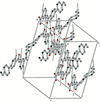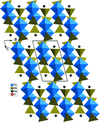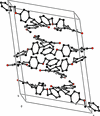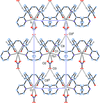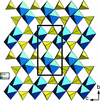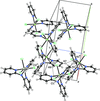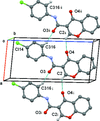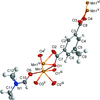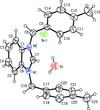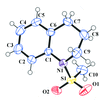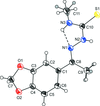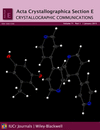issue contents
January 2015 issue

Cover illustration: The crystal structures of four N-(4-halophenyl)-4-oxo-4H-chromene-3-carboxamides (halo = F, Cl, Br and I) are described. Each molecule features intramolecular N-H O and C-H
O and C-H O hydrogen bonds, which help to establish a near planar conformation. This may correlate with their promising monoamino oxidase inhibitor activity, which could lead to new insights into possible treatments of Parkinson's disease. See: Gomes, Low, Cagide & Borges [Acta Cryst. (2014). E70, 88-93].
O hydrogen bonds, which help to establish a near planar conformation. This may correlate with their promising monoamino oxidase inhibitor activity, which could lead to new insights into possible treatments of Parkinson's disease. See: Gomes, Low, Cagide & Borges [Acta Cryst. (2014). E70, 88-93].
research communications
Download citation


Download citation


The title compound crystallized with two independent molecules in the asymmetric unit. In the crystal, they are linked to one another, forming chains enclosing  (10) and
(10) and  (12) ring motifs.
(12) ring motifs.
CCDC reference: 1034620
Download citation


Download citation


A new triple molybdate K0.4Na3.6Co(MoO4)3 was synthesized using solid-state reaction at 973 K and characterized by X-ray diffraction. The structure is characterized by M2O10 (M = Co/Na) dimers, which are linked by MoO4 tetrahedra, forming infinite layers. The latter are connected on one hand by insertion of Mo1O4 tetrahedra and secondly by sharing corners with Mo2O4 tetrahedra.
CCDC reference: 1036131
Download citation


Download citation


In the title compound, the ring conformations of the tricycles are in an envelope, a half-chair and a chair. In the crystal, intermolecular O—H⋯O and C—H⋯O hydrogen bonds and C—H⋯π interactions link the molecules into a three-dimensional architecture.
CCDC reference: 1036428
Download citation


Download citation


In two cyclohepta[b]pyridine-3-carbonitrile derivatives, the cycloheptane ring adopts a half-chair conformation. In the crystals of both compounds, pairs of N—H⋯Nnitrile hydrogen bonds link the molecules, forming inversion dimers with  (12) ring motifs.
(12) ring motifs.
Download citation


Download citation


5-(4-Benzyloxyphenyl)-3-(4-methoxyphenyl)-6-methylcyclohex-2-en-1-one crystallized with two independent molecules in the asymmetric unit. The cyclohexene ring adopts an envelope conformation in both molecules, with the C atom to which is attached the central benzene ring as the flap. The crystal packing, is stabilized by C—H⋯π interactions.
CCDC reference: 1035112
Download citation


Download citation


Reaction of 4-methyl benzyl chloride with barbituric acid gave 5,5-bis(4-methylbenzyl)pyrimidine-2,4,6(1H,3H,5H)-trione, which crystallized with two molecules in its asymmetric unit along with two solvent water molecules. A hydrogen-bonded sheet is formed by a combination of N—H⋯O and Owater—H⋯O hydrogen bonds, which are further interconnected by C—H⋯πaryl interactions, leading to a three-dimensional supramolecular architecture.
CCDC reference: 1036677
Download citation


Download citation


The crystal structures for five PdII complexes containing the tridentate ligand bis[2-(3,5-dimethylpyrazol-1-yl)ethyl]amine (pza) are reported. The co-ligand completing the square-planar coordination of the PdII centre influences the conformation of the pza ligand.
Download citation


Download citation


The title compound crystallized with two independent molecules (A and B) in the asymmetric unit, which differ essentially in the orientation of the terminal aminophenyl ring with respect to the central benzene ring. In the crystal, molecules are linked via N—H⋯O hydrogen bonds forming –A-B–A–B– zigzag chains propagating along [010].
CCDC reference: 1036844
Download citation


Download citation


The structures of two isomeric compounds of isoquinoline with 3-chloro-2-nitrobenzoic acid and 4-chloro-2-nitrobenzoic acid have been determined at 190 K. In each compound, the acid and base molecules are held together by a short hydrogen bond between a carboxy O atom and a base N atom. In the hydrogen-bonded unit of the former, the H atom is disordered over two positions, while in the latter, an acid–base interaction involving H-atom transfer occurs and the H atom is located at the N site.
Download citation


Download citation


The title compound has an almost planar 1,2-dibenzylidenehydrazine backbone with an approximately orthogonal planar phenyl ethanone substituent on one of the imine C atoms. In the crystal, molecules are linked via C—H⋯O hydrogen bonds and C—H⋯π interactions, forming a three-dimensional structure.
CCDC reference: 1036846
Download citation


Download citation


The title compound packs with a three-dimensional supramolecular architecture via O—H⋯O, C—H⋯O and C—H⋯Cl hydrogen bonds and through C—H⋯π interactions.
CCDC reference: 1024474
Download citation


Download citation


[UO2(acac)2(ppp)] is constructed from one uranyl(VI) unit, two anionic acetylacetonate (acac) ligands and one 1-phenyl-3-(pyridin-4-yl)propane (ppp) ligand. The U atom exhibits a UNO6 pentagonal–bipyramidal coordination geometry; two uranyl(VI) O atoms are located at the axial positions, whereas four O atoms from two chelating bidentate acac ligands and one N atom of a ppp ligand form the equatorial plane.
CCDC reference: 1037284
Download citation


Download citation


A dirhenium(III) cis-dicarboxylate complex is reported, which is representative of a small class of zwitterionic ammoniacarboxylato complexes involving a quadruple metal–metal bond.
CCDC reference: 1037487
Download citation


Download citation


Solid-state polymerization behavior of amino acid N-carboxy anhydrides is explained by the very preferable molecular arrangement for the reaction in the crystal structure.
CCDC reference: 1038016
Download citation


Download citation


A redetermination of the crystal structure of minodronic acid monohydrate was carried out in order to provide accurate atomic coordinates and geometry information, whose knowledge is fundamental to elucidate the presumed polymorphism of the compound at room temperature.
CCDC reference: 1038087
Download citation


Download citation


The crystal structure of magnesium copper(II) bis[orthophosphate(V)] monohydrate is formed by three types of cationic sites and by two unique (PO4)3− anions. One site is occupied by Cu2+, the second site by Mg2+and the third site by a mixture of the two cations with an Mg2+:Cu2+ occupancy ratio of 0.657 (3):0.343 (3).
CCDC reference: 1038224
Download citation


Download citation


A new monoclinic (P21/c) polymorph of the title compound has the same overall conformation as a previously reported (Cc) form with the exception of the conformation of the outer hydroxy H atom. This difference results in very different crystal packing based on hydrogen bonding, i.e. supramolecular tubes in the new form as opposed to a three-dimensional architecture in the Cc form.
CCDC reference: 960620
Download citation


Download citation


The crystal structure of the title compound displays boat and half-chair configurations of the thiazine ring.
CCDC reference: 1037009
Download citation


Download citation


The reaction of terbium(III) nitrate pentahydrate in acetonitrile with N,N′-bis(2-hydroxybenzyl)-N,N′-bis(pyridin-2-ylmethyl)ethylenediamine (H2bbpen), previously deprotonated with triethylamine, produced the mononuclear compound [Tb(Cbbpen)(NO3)]. The molecule lies on a twofold rotation axis and the TbIII ion is eight-coordinate with a slightly distorted dodecahedral coordination geometry.
CCDC reference: 1037922
Download citation


Download citation


In the new molybdenum oxide potassium pentasodium trimanganese hexakis(molybdate), KNa5Mn3Mo6O24, the structure is composed of M2O10 (M = Mn, Na) dimers and MoO4 tetrahedra sharing corners and forming layers which are linked via common corners of another type of MO4 tetrahedra, forming a three-dimensional structure with two types of large channels in which the Na+ and K+ cations are located.
CCDC reference: 1038636
Download citation


Download citation


The CrIII ion in the title compound is bonded to three N atoms that are constrained to a facial arrangement by the tris(pyridin-2-yl)amine ligand and by three chloride ligands, leading to a distorted octahedral coordination sphere.
CCDC reference: 1038512
Download citation


Download citation


In this one-dimensional coordination polymer, four symmetry-independent Li(C5H3N2O2)(H2O) units form molecular ribbons running along the unit-cell c-axis direction. Within each ribbon, the ligand molecule, acting in a μ2-mode, bridges two adjacent Li cations using both its N,O-bonding sites.
CCDC reference: 1037774
Download citation


Download citation


Besides intramolecular O—H⋯N hydrogen bonds, the crystal structure displays intermolecular O—H⋯O and C—H⋯O hydrogen bonds linking the molecules into undulating layers parallel to the ( 01) plane.
01) plane.
CCDC reference: 1038806
Download citation


Download citation


The redetermination of the crystal structure of lead tartrate from crystals grown in a gel medium confirmed the previous powder X-ray diffraction study in the space group P212121 with higher precision. Contradictions in the literature regarding space group and water content could be clarified.
CCDC reference: 1039408
Download citation


Download citation


In the title compound, the six-membered ring which includes the P atom has a chair conformation and three O atoms are bonded in a trigonal–pyramidal manner to the P atom. In the crystal, molecules are linked via C—H⋯π interactions, forming slabs lying parallel to (10 ).
).
CCDC reference: 1037929
Download citation


Download citation


In four N-(4-halophenyl)-4-oxo-4H-chromene-3-carboxamides, halo = -F, -Cl, -Br and -I, the molecules are essentially planar and exhibit anti conformations with respect to the C—N rotamer of the amide and with cis geometries with respect to the relative positions of the C3arom—C2arom bond of the chromone ring and the carbonyl group of the amide.
Download citation


Download citation


In the solid state, the title compound, adopts the keto–amine tautomeric form, with the H atom attached to the N atom, which participates in an intramolecular N—H⋯O hydrogen bond with an S(6) ring motif. In the crystal, molecules are linked by weak C—H⋯O hydrogen bonds to generate C(16) chains propagating in the [301] direction.
CCDC reference: 1038012
Download citation


Download citation


The 4,4′-(ethane-1,2-diyl)bis(2,6-dibromoaniline) molecule lies across an inversion center and hence the benzene rings are strictly planar. Molecules are linked by N—H⋯N and weak N—H⋯Br hydrogen bonds, forming a two-dimensional network parallel to (101). Type II Br⋯Br interactions complete a three-dimensional supramolecular network.
CCDC reference: 1038844
Download citation


Download citation


The CrIII atoms in the title compound show a distorted octahedral coordination with four N atoms of two ethane-1,2-diamine ligands (en) in the equatorial plane and two N-coordinated NCS− groups in axial positions. The [ZnCl4]2− anion has a slightly distorted tetrahedral geometry.
CCDC reference: 1039747
Download citation


Download citation


In the title compound, the tautomer present in the solid state is that in which the immediately exocyclic N atom bears the H atom. The central five-membered ring is planar, but both its N atoms are significantly pyramidalized.
CCDC reference: 1040102
Download citation


Download citation


The title compound is a one of the first-step hydrolysis products of thalidomide. In the crystal, each molecule is linked via six neighbouring molecules into a three-dimensional network through N—H⋯O and O—H⋯O hydrogen bonds.
CCDC reference: 1038803
Download citation


Download citation


In the crystal of the title compound, molecules are linked by N—H⋯O hydrogen bonds between the imino group and the carbonyl O atom in the ethyl ester group, forming a tape structure along the c-axis direction. The oxazolidine rings of adjacent tapes are arranged into a layer parallel to the ac plane, which is a favourable arrangement for the polymerization of the title compound in the solid state.
CCDC reference: 1038820
Download citation


Download citation


Cyclo(Phe1–D-Ala2–Gly3–Phe4–APO5) is the minor diastereoisomer of a cyclic penta-peptidomimetic analogue containing a novel 2-aminopropyl lactone (APO) motif, which displays the same number of atoms as the native amino acid glycine and has a methyl group in place of the carbonyl O atom.
CCDC reference: 1039448
data reports
inorganic compounds
Download citation


Download citation


metal-organic compounds
Download citation


Download citation


Download citation


Download citation


Download citation


Download citation


Download citation


Download citation


Download citation


Download citation


Download citation


Download citation


Download citation


Download citation


Download citation


Download citation


organic compounds
Download citation


Download citation


Download citation


Download citation


Download citation


Download citation


Download citation


Download citation


Download citation


Download citation


Download citation


Download citation


Download citation


Download citation


Download citation


Download citation


Download citation


Download citation


Download citation


Download citation


Download citation


Download citation


Download citation


Download citation


Download citation


Download citation


Download citation


Download citation


Download citation


Download citation


Download citation


Download citation


Download citation


Download citation


Download citation


Download citation


Download citation


Download citation


Download citation


Download citation


Download citation


Download citation


Download citation


Download citation


Download citation


Download citation


Download citation


Download citation


Download citation


Download citation


Download citation


Download citation


Download citation


Download citation


Download citation


Download citation


Download citation


Download citation


Download citation


Download citation


Download citation


Download citation


Download citation


Download citation


Download citation


Download citation


Download citation


Download citation


Download citation


Download citation


Download citation


Download citation


Download citation


Download citation


Download citation


Download citation




 journal menu
journal menu











